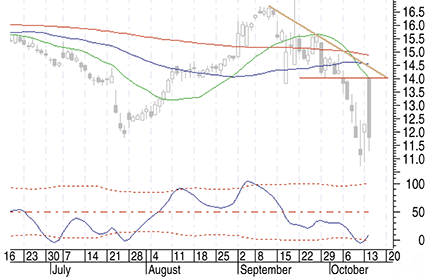INDICATORS
Six Tricks To Buy And Sell
Smoothing The Bollinger %b
Part 2
In the second part of this series, you will find out how to use the author’s version of the Bollinger %b indicator as a trigger to buy and sell a stock. To succeed, you’ll have to pull a few tricks out of the technical analysis toolkit.
Often, the Sve_BB%b is a leading indicator making smooth moves with clear turning points. Normal and hidden divergent moves make it an ideal tool to help find entry and exit points while watching price moving between the Bollinger bands. In my last article, I looked at how this indicator could help traders identify entry and exit points while prices are moving between the bands. This time, I will introduce a good trading system using the Sve_BB%b and include some ideas together with other technical analysis tools. There are some tricks that could help traders get started:
- Use a candlestick chart when applying the Sve_BB%b. This is because candlesticks tell you more. You will look for candlestick reversal patterns to get a confirmation of a possible turnaround.
- Use the most basic tools like support, resistance, and trendlines. Knowing that the Sve_BB%b is a leading indicator, you will just use the turning points of the indicator above and below the active standard deviation reference levels as a signal to start drawing a trendline and not as a signal for a direct buy or sell.
- Keep a close eye on convergent and divergent moves between price and indicator. Ideally, you would open or close a position after a standard positive or negative divergent move. The bottoms or tops of this divergence are preferably spaced closer together than the price move before the divergence because price correction waves are generally moving faster than price trend waves. Look for hidden divergences and interpret them as a possible continuation of the previous up- or downtrend.
- Use 20-, 50-, and 200-day simple moving averages. Use the 20-day simple moving average as an aid to draw trendlines with the short-term price move. Use the 50- and 200-day simple moving averages as dynamic support and resistance levels.
- Use a fast-responding trailing stop to get in and out of a trade. A good example would be one like my Tr&nds trailing stop introduced in the July 2009 issue of Stocks & Commodities. Use this stop as a warning signal. Look closely at the evolution of price at that moment in time. This trailing stop is considered broken only if crossed by the high price.
- Always take care of the risk-to-reward ratio before entering a trade.

Figure 1: SVE_BB%b APPLIED TO convergys corp (CVG). Here you see the SVE_BB%b turning up from below the lower dynamic reference level.